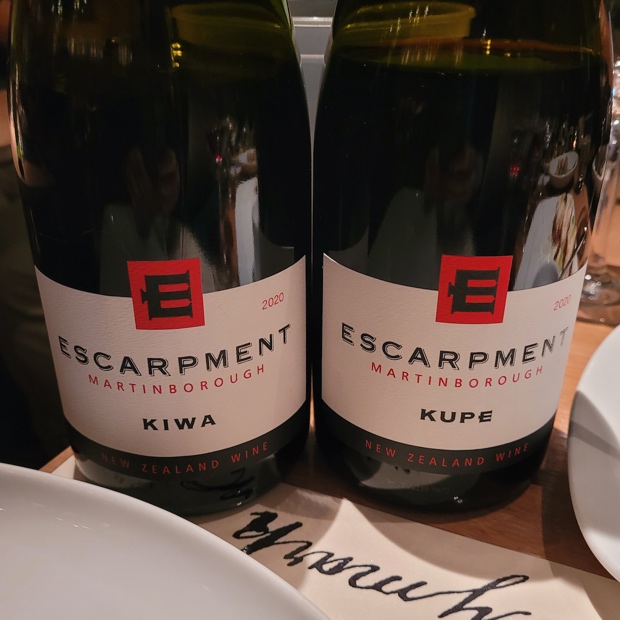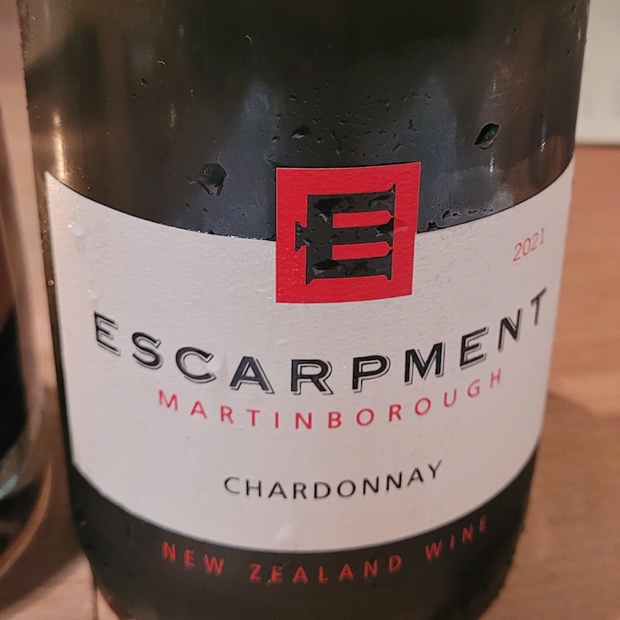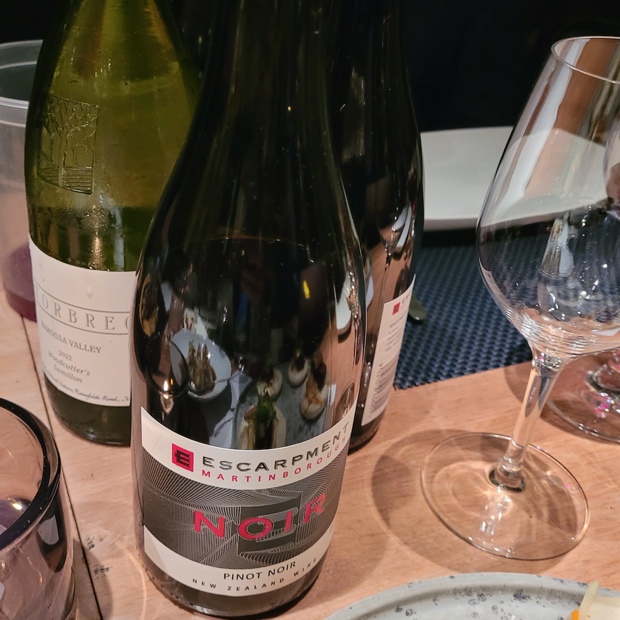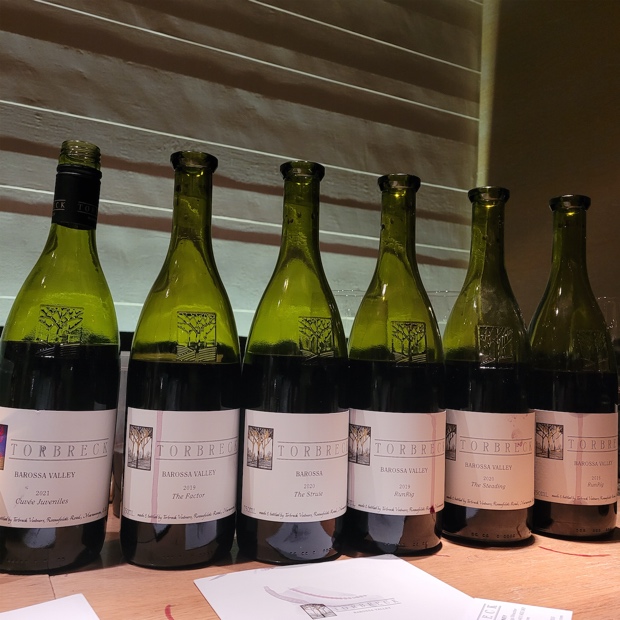Some of the worlds oldest vines continue to thrive in South Australia’s Barossa Valley and 3,600 kms away in Martinborough, New Zealand there are some vines upwards of 35 years of age now entering into their experiential phase. First there is the 1994 founded Torbreck Vintners, one of the Barossa’s upper echelon producers of bonzer shiraz, Rhône-inspired red blends, sémillon and a grenache to rival any in this world. Second along comes Escarpment Wines, a recent addition to the Torbreck portfolio created by the Marchesi of Martinborough himself, that being Larry McKenna back in 1999. The winery was originally established as a partnership between McKenna, his wife Sue, along with Robert and Mem Kirby, at a vineyard planted on the Te Muna river terraces, a few kilometres east of Martinborough town. McKenna had been in Martinborough since 1984, involved in the vineyards since ’86 and the winery was recently purchased by Torbreck in 2019.
Back in September Torbreck’s Sales, Export and Marketing Director Andrew Tierney was in Toronto and so John Szabo MS and I sat down with him and his importing agent Craig de Blois of Noble Estates. We paced steadily with concerted haste through five Escarpment and eight Torbreck wines. Some will soon show up in VINTAGES and also by way of Classics catalogue releases from now through the Spring of 2023. Here are my notes on the 13 wines.
Escarpment Chardonnay 2021, Martinborough, New Zealand
Founder Larry McKenna had been in Martinborough since ’84, involved in the vineyards since ’86, started the property in ’99, mainly to chardonnay and pinot noir with a bit of pinot gris. Purchased by Torbreck in 2019. Alluvial-gravel soils and a property (Escarpment) that needed an infusion of commercial advantage. Quite a flinty strike, reminiscent of the Dog Point style in whites but here clearly attributable to the terroir. Low density in the new plantings and low volume output. From the original plantings (or at least those that survived Phylloxera) and a wine that sees no barrique, only puncheons. Intensity of tart and taut behaviour, lees-textured though nothing creamy caused by stirring. Gets to the top of the sides of the palate, lingers for a cocktail or two and slowly drifts away. Unique set of chardonnay circumstances right here. Drink 2022-2025. Tasted September 2022
Escarpment “Noir” Martinborough Pinot Noir 2020, Martinborough, New Zealand
Considered an “entry-level” pinot noir, poured first and leading into a few “Premier and Grand Cru” iterations. Consider this more of a mini or multi-Villages style or plan, done in stainless steel and old barrels. A combination of vineyard across Martinborough of fruit de-classified away from the Villages and Cru wines. Shows off that darker and mineral-stony intensity of varietal fruit and therefore quite typical for the greater sense of place. As floral as expected or better yet wanting it to be, strength of aromatic sense and then herbal though savoury so, like fennel and drying roses. Drink 2022-2024. Tasted September 2022
Escarpment Pinot Noir 2019, Martinborough, New Zealand
The next Escarpment steppe is a “Villages” level pinot noir, composed of 60-70 per cent estate fruit plus other Martinborough “Villages” sourced fruit. The next level concentration but more so the complex notions of fungi and Piedmontese-esque tar and roses take this to another level entirely. You need to take time here, allow the aromatics to rise and hover, pause again and then consider the range of flavour escaping with emotion. The encapsulation of Martinborough falls into and emerges from this Villages and my how it strikes a chord. Drink 2023-2025. Tasted September 2022
Escarpment Pinot Noir Kiwa 2020, Martinborough, New Zealand
From the oldest (1.8 hectare) block with a higher level of alluvial-gravel, a township vineyard close to Ata Rangi, dating back to 1994. Expect high mineral and tannin though that is not necessarily what will come from sister bottling Kupe. Taking concentration, sensation and fascination to another level yet again, aromatic sure but harder to get and fully comprehend. Yet you know and intuit another dimension and scope of varietal fortitude, due to soil and place, someway, somehow. This is whole and a wine of breadth, clustered by 30-40 per cent intact berries and thereby a true gifting of the veritable pinot noir. Drink 2024-2029. Tasted September 2022
Escarpment Pinot Noir Kupe 2020, Martinborough, New Zealand
One hundred per cent Abel clone smothered and then smuggled from “somewhere” in France, here from a block that suggests 60-70 whole cluster fermentation and the winemaking team abides. There is a pickling effect, a reductive reticence and a demand in taut intensity by way of tension that would not want to open up any time soon. Showing some nightshade leafiness though subtly so and surely a component that will dissipate with time. A beast? Perhaps the term of endearment could be used but it should be considered more in terms of weaponry, medieval to a degree but a warrior’s accoutrement accruements for sure. Return before the next moment of strife to check in and see where Kupe is at. Drink 2025-2033. Tasted September 2022
Torbreck Woodcutter’s Sémillon 2022, Barossa Valley, South Australia
From plantings of 1984 and 1998 and yes indeed the first 2022 wine tasted (for now). Just over a third is aged in wood and the vintage was as non dramatic as it gets, “a good year,” tells Andrew Tierney, “no drought, no wildfires, no bad winds.” Bit more downy texture and fulsome mouthfeel than many which will surely equip this sémillon with the kind of stature to age into something elastic and forever. This will surely include buttered brioche and lemon curd, eventually. Just imagine how upper echelon, world class this wine could be were it’s vineyards farmed and crafting approached with religious reverence. Drink 2022-2025. Tasted September 2022
Torbreck Cuvée Juveniles 2021, Barossa Valley, South Australia
The first vintage that contains fruit from the recent carignan and cunoise plantings (2017) to go along with the syrah, grenache and mourvèdre. The “Côtes de Barossa” of Torbreck’s Rhône portfolio with such an added savoury element now that the C’s are involved and balancing out with the S, G and M. Gone are the days of confectionary pleasantries (a relative thing to say) and welcome to equanimity but better still Barossa Valley range. The new umami and depth descended than before. a great direction to be sure. Drink 2023-2027. Tasted September 2022
Torbreck The Steading 2020, Barossa Valley, South Australia
Here Torbreck’s world enters what can be considered and even referred to as “Châteauneuf de Barossa,” a place where a multitude of Rhône grapes gather for the full and complimentary layered effect. A true G-S-M, first made in 1996 and by many accounts the signature red wine of the company. Rich and structured, built for aging. Ages in large foudres and while it will almost certainly retract in a year or so, for now the open juiciness and up front beauty is there for the preview. Just wait until the 2017 plantings of carignan and counoise mature and join this mix. The future will be exciting indeed. Drink 2022-2025. Tasted September 2022
Torbreck Grenache Hillside Vineyard 2019, Barossa Valley, South Australia
Planted in 1949, all dry-farmed bush vine grenache on an estate property at 180m of elevation. The fruit used to go into The Steading but now finds its way into one large foudre for this lithe, elegant and copacetic example of pure grenache. Hard to find a Barossa Charter for Old Vines example any more impressive as a provider than this, a parent, grandparent and great-grandparent set of vines gifting a current vintage with all the acumen, experience and nurturing that is seemingly impossible but so very wanted. Started in 2017 with the elimination of small casks because grenache absorbs and then oxidizes, better best done up in foudres for the right result. Here the grenache swirls, inclusive of raspberry, then variegates (with far eastern Illicium Verum spices) and expands aromatically, in complex flavours and truth be told, über concentrated freshness. Gorgeous and honest wine. Drink 2024-2034. Tasted September 2022
Torbreck The Struie 2020, Barossa Valley, South Australia
Label does not say it (it’s a Torbreck thing) but this is solo shiraz, from “intermediate” vineyards in the 70-80 year range, 75 per cent from the Valley and the rest outside. Sure there is a feeling gained that’s expressly shiraz from Barossa but what’s more and truly important is this silken seamlessness, the glycerol and mint coulis that grabs the palate’s full attention. To grow at this quality level the yields have to be devilishly low, not an easy task when you’re working with 30 contract growers. Sustainably farmed and regionally framed in a shiraz of fruit, meat and sweet herbs, nothing tarry, charred or rustic about it. Smooth as it gets. Truth. Drink 2024-2030. Tasted September 2022
Torbreck Shiraz The Factor 2019, Barossa Valley, South Australia
The essential difference between Struie and Factor is complicated but the limiting is to four vineyards (90 to 125 years of age, in stone, sand, clay and red Barossa loam) and 40 per cent in French oak. The viscosity is again palpable but now so bloody accentuated, elongated, elasticized and multiplied in the Factor. Thus the name? Not exactly (or likely) but this is indeed a matter of place(s) and purpose. No deception in this depth, nor in the execution neither. Need to find more word hyperboles for glycerol and mouthfeel so bare with me for a moment.. Let’s call Factor a shiraz “triol bond multiplied by hydroxyl bomb” with the result being a diatomic molecule simply called “Radical.” Drink 2026-2037. Tasted September 2022
Torbreck RunRig 2019, Barossa Valley, South Australia
Six vineyards go into RunRig, 90-170 years of age, four estate and two by growers, from Lindoc to Ebeneezer. There is a tiny percentage of viognier added at bottling and the wines that are not chosen will end up in the Struie and The Factor. A drought year and there seems no real need to compare with those wines. The level of fortitude, intensity, trenchant purpose and just plain gumption is off the charts, shiraz or not, with a “willingness to get things done and just let this wine do the talking.” Not the solo black fruit that the others show but a full hematoma of hue and drupe, blues and reds in the scheme. Full varietal aperture, slow shutter speed and clarity like no other. Vintage snapshot captured that will live in infamy. Drink 2024-2039. Tasted September 2022
Torbreck RunRig 2016, Barossa Valley, South Australia
Six vineyards go into RunRig, 90-170 years of age, four estate and two by growers, from Lindoc to Ebeneezer. There is a tiny percentage of viognier added at bottling and the wines that are not chosen will end up in the Struie and The Factor. Surely age has begun to make a minor difference but more than anything it is a vintage that sets the record straight. RunRig was one thing and like all great wines has to change so here the set is that of a twain. And so 2016 marks the turn from one era towards another and establishes a revised launch point to accrue the new benchmark. Shiraz yes but a wine of certitude and confidence to transcend varietal definitions and celebrate some of the oldest plots in the land. Sure the texture is silky smooth but the “it factor” concerns these layers to peel away and the depths of (opposite of despair) that put this wine where it wants to be. Drink 2023-2029. Tasted September 2022
Good to go!
godello
Twitter: @mgodello
Instagram: mgodello







Grazie Mille!!
Sent from my iPhone